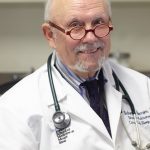Guest post by Sidney Braman, MD, Professor Pulmonary, Critical Care and Sleep Medicine Division, Icahn School of Medicine at Mount Sinai. Dr. Braman has long standing expertise in managing diseases of the airways such as asthma and COPD.
Chronic obstructive lung disease (COPD) is a progressive disease that affects about 11 million adults in the U.S., although many more have the disease and do not know it. It has become the third leading cause of death and results in chronic disability and a heavy financial and emotional burden on the patient and family alike. COPD is preventable, as the cause in up to 90% of individuals is cigarette smoking. Occupational irritants and passive smoke exposure are also thought to play a causative role. In the second half of the 20th century the tobacco industry began advertising heavily to women. As a result, although COPD had been considered a disease of men, more women have developed the disease, and by 2001 more were dying of COPD than men. As not every smoker develops COPD, genetic susceptibility also plays a role in causing the cigarette-induced damage to the lungs. In the susceptible smoker the exposure causes intense inflammation and this results damage to the bronchial tubes (chronic bronchitis) and destruction of the lung tissue (emphysema) that can be detected by a simple breathing test.
The symptoms of COPD usually begin in mid-life. The main symptom is shortness of breath on exertion and as the disease progresses patients become very sedentary. Many patients have a daily cough with expectoration of mucus. Smoking cessation can have positive effect on the cough and can slow down disease progression. But, once damage is done and lung function is reduced, the lung function can never return to normal. Currently prescribed medications can improve exercise tolerance and overall quality of live. They open up the bronchial tubes (bronchodilate) and reduce the inflammation. In later stages of the disease oxygen may be required and exercise programs (pulmonary rehabilitation) may be suggested.

